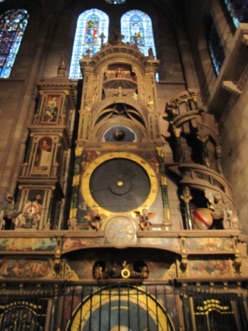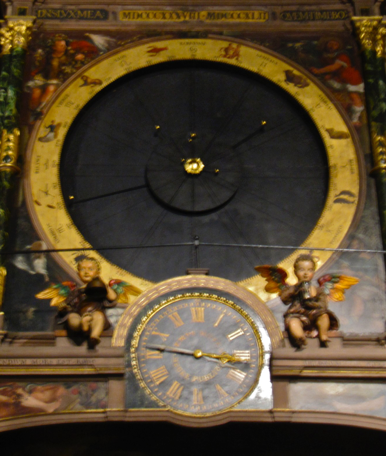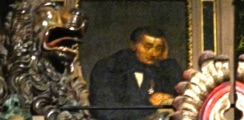Astronomical CLOCK
Cathédral de notre-dame-de-Strasbourg
Alsace, northern france
europe
december 17-22, 2011


Astronomical CLOCK
Cathédral de notre-dame-de-Strasbourg
Alsace, northern france
europe
december 17-22, 2011


The Cathédaral de Notre-Dame de Strasbourg has been the site of three spectacular clocks, the first of which was built in the 14th century, erected between 1352-54. Known as the “Three Kings Clock”, the automata on the clock included the Three Kings who bowed before the figure of the Virgin Mary and the Christ Child. On top of the clock was a gilded rooster made of iron, wood, and copper, re-used in the Second Clock, but now housed in the Museum of Decorative Art as the oldest preserved automaton worldwide. The bird represented the passion of Christ. At noon, the cock would open its wings, put out its tongue and crow. Bellows and a reed enabled the bird to emit sound. It is thought that the mechanics of this clock had contained an astrolabe dial and a calendar dial, and the entire construction stood at 18 meters 59 feet in height and 7.6 meters (25 feet) in width, though it was positioned on the wall opposite the current clock.
The Second Clock was built in the 16th century (c. 1547), designed by the mathematician Christian Herlin. Work was halted for several reasons, including the deaths of Herlin and his associates. There were also political problems, and the cathedral became Catholic. When construction resumed, Conrad Dasypodius, a pupil of Herlin took over. To assist in the design and building of the clock, he hired the Swiss Clockmaker Josia Habrecht , the astronomer and musician, David Wolckenstein, and Swiss artists Tobias and Josias Stimmer. The clock was completed in 1574. The clock was well-endowed with paintings, moving statues, automata, and musical entertainment in the form of a six tune carillon. Painted panels depicted the three Fates, Urania, Colossus, Nicolaus Copernicus, and various sacred themes including the Creation, the resurrection of the Dead, the last judgment and the rewards of virtue and vice. There was also an 86 cm (34 inch) diameter globe connected to the clock movement, set for the meridian of Strasbourg, and accompanied by a figure of a pelican. The golden rooster from the First Clock was mounted on top of the cupola and continued to entertain visitors at noon with its flapping wings and crowing. In 1640, the cockerel was struck by lightning. The clock stopped working around 1788 and stood still until 1838.
The Third Clock by Jean-Baptiste Schwilgué (1776-1856); his boyhood dream was to work on the clock. Fifty year later, after he had become acquainted with clockmaking, mathematics, and mechanics, he was awarded the contract. Schwilgué spent one year preparing his 30 workers before beginning construction, which lasted almost five years, between 1838 and 1843. Features of this clock include automata, a perpetual calendar, a planetary dial, a display of the real position of the Sun and the Moon, and solar and lunar eclipses. Time can be marked with the hour of the day, the day of the week (each represented by a god of mythology), the month, the year, the sign of the zodiac, the phase of the moon, and the position of different planets. The mechanics of the clock are akin to a complex calculator as the precision instrument can determine the date of Easter: the Sunday that follows the fourteenth day of the moon that falls on March 21 or immediately thereafter; this being accurately accounted before computers! At different hours during the day, a mechanism engages to launch animated characters into movement. For example, one angel sounds the bell while a second angel turns over an hourglass. Various characters represent the stages of life, from child to old man, each parading in front of Death. The main attraction on the clock is the procession of the figures of Christ and the Apostles (each 42.7 cm or 18 inches high), which occurs every day at 12:30 pm while the life-sized cock crows three times. The inauguration, of this clock took place on December 31, 1842 predating its completion.
PHOTOS: Top Three: 1. A view of the 18 meter/59 foot high astronomical clock in the Cathédrale de Notre-Dame de Strasbourg. 2. Detail: one of the paintings and a sculpture decorating the clock. 3. View of the Astrological clock depicting the months and zodiac signs. Two cherubs and an actual clock are at the bottom of this Second tier. Bottom: View of the ground level of the clock showing the astrological mechanics and the globe that stands before it, with Strasbourg’s GPS coordinates depicted to calculate the correct time. Two female figures

One of the World’s Largest Clocks



